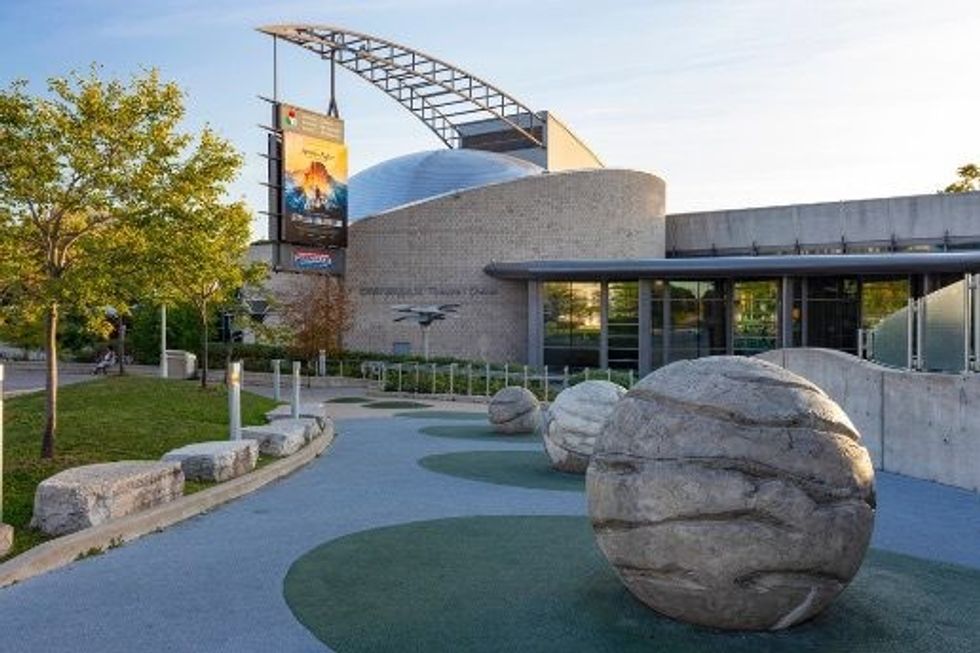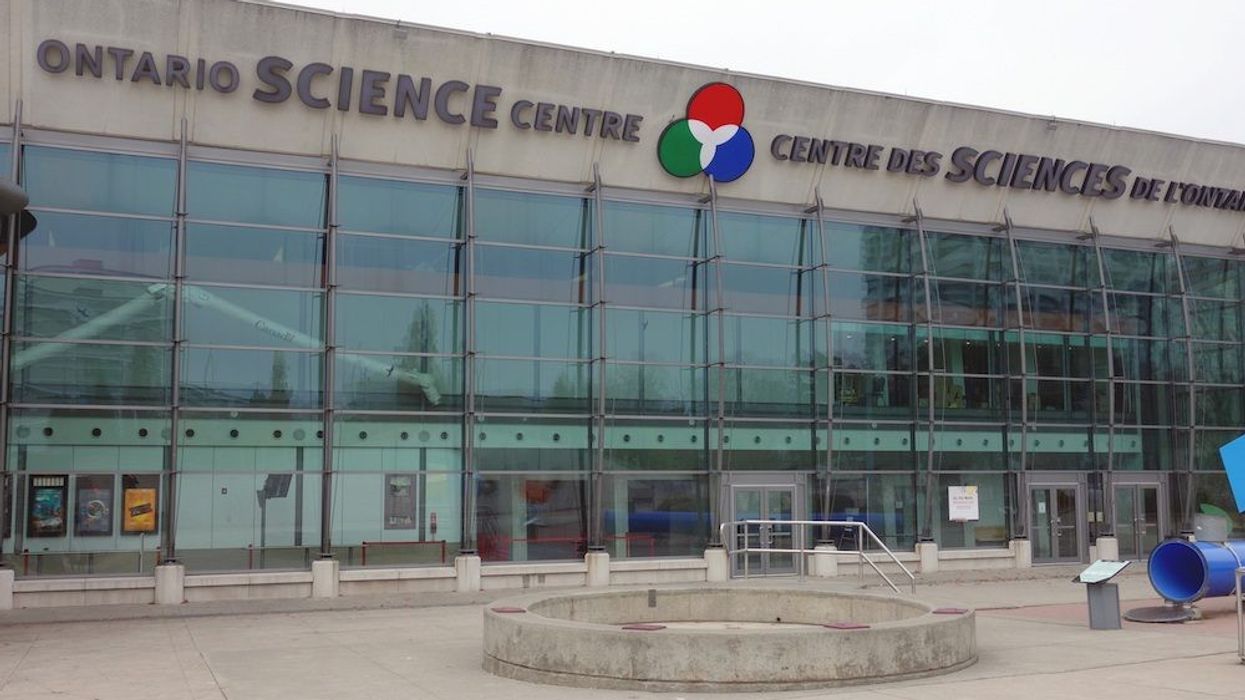“It’s no consolation at all,” says Toronto City Councillor Jon Burnside of the potential for affordable new homes in his ward in exchange for the beloved Ontario Science Centre.
Not only does Burnside believe that the Science Centre -- a 1969-opened science museum and arguably the crown jewel of his Don Valley East ward -- should stay where it is, he says the neighbourhood doesn’t need any more homes. In fact, it can’t handle them, he attests.
For those somehow still in the dark, the Science Centre has become a major talking point in Toronto’s current mayoral race, especially after last week’s splashy announcement by Premier Doug Ford that the institution would move to Ontario Place as part of the latter’s widespread -- and highly controversial -- planned revamp. Current plans call for the existing Science Centre buildings to be demolished.
RELATED: Fate of Ontario Place Steals Spotlight as Toronto’s Mayoral Race Heats Up
Ontario's minister of infrastructure, Kinga Surma, said that the province issued a business case to determine that it was more cost effective to relocate the Science Centre than for it to stay in its current location. Ford says that much-needed housing would go in its place.
As mayor, candidate Ana Bailão has said she would approve building 5,000 new homes -- including 1,500 affordable homes -- on the city-owned land where the Science Centre’s parking lot is, and on the land outside of the ravine. “Our city is facing both an affordability and a housing crisis -- we need to be focused on fixing services and building housing to make life better and more affordable for people,” Bailão told STOREYS in a statement. The once relatively isolated plot of land is now highly serviced by new and upcoming transit additions.
“I think it’s actually quite a brilliant move,” says Toronto-based urban planner Naama Blonder of the Science Centre’s relocation. “The Science Centre was historically in the middle of nowhere. Now, it’s at an intersection of two new transit lines; the Eglinton Crosstown LRT and the upcoming Ontario Line. Where else should we put new, needed housing other than at two new transit lines?”
Damon Conrad, Royal LePage’s National Director of Commercial Real Estate, also highlights the potential in the two subway stations that will straddle the site. “This will form a major transit hub, implying high-density, mixed-use development for properties within the Major Transit Station Area (MTSA),” says Conrad. “Giving the property’s high profile location with dual frontage on Eglinton and Don Mills Roads, the site is ideal for developments that may include residential towers, a commercial-lined public square, community centre, school, child care, and open spaces.”
Conrad says the site can accommodate multiple residential towers ranging in heights from mid-rise to high-rise -- 15 to 60+ storeys -- likely designed around the natural heritage features of the site. “You could envision a massive project similar to what Aspen Ridge Homes has built on the north side of the site with its Crosstown Community,” he says. Crosstown Community is a new master-planned community on 60 acres of land that will include 390 new affordable rental homes.
When it comes to the aging Science Centre, one thing everyone can agree on is that it’s seen better days. Blonder says that the Science Centre has also experienced a dwindling number of visitors in recent years. “It doesn’t attract many visitors anymore and, let’s face it, it could benefit from a new contemporary design,” says Blonder. “The building is old and dark. I think it’s an incredible opportunity and smart move to bring it to the waterfront -- a location that is highly accessible -- and also not a future development land.”
Unsurprisingly, relocating the Science Centre has been met with no shortage of backlash -- and some confusion. Its original architects are calling for the buildings to be preserved. “The purpose of the Science Centre is inseparable from the site it currently inhabits,” reads a statement from the firm. “At Moriyama Teshima Architects, we believe the science is unequivocally telling us that we need to be preserving and regenerating our buildings. The carbon embodied in these structures is too valuable to discard.”
The firm says that, should the Science Centre modernize and evolve, that the goal should be to revitalize it in a way that celebrates its heritage and unique architecture and restores its commitment as a neighbourhood amenity.
“A regenerated Science Centre should continue its legacy of education, and can accommodate other uses such as community space, or even housing, if deemed appropriate,” the statement continued. “Likewise, if there is a need for a new public institution along the shores of Lake Ontario, let’s expand the mission and the footprint of the Science Centre, and explore a new facility that celebrates and explores that site’s unique surroundings.”
Yesterday, the Toronto and Region Conservation Authority (TRCA), Ontario’s largest conservation authority, said it was not consulted before Ford’s big announcement, despite owning the land. The TRCA says it’s been left in the dark by the Province and the City of Toronto on the decision to move the Science Centre, build on its land, or severe the 99-year lease agreement that's in place, which isn’t set to expire until 2064. The current lease only permits the construction of structures “for purposes of operating as a science centre.”
The authority owns 81 acres of land in the region, including portions of the Science Centre, ravine lands, the Don River and West Don Trail, Seton Park, greenspace, and sensitive habitats considered hazardous to develop on. The TRCA says it has reached out to the Province for clarification on the matter and looks forward to learning more about its proposed plans.
Environmental and ecosystem considerations aside, Burnside says that the Science Centre represents much more than a local attraction for the surrounding community and that its loss would be felt immensely.
“The value add of moving the Science Centre down to Ontario Place -- where there are about 100 other ideas and things going on -- is minimal,” says Burnside. “But the negative impact on the [Don Mills] community is magnified. That area is a Neighbourhood Improvement Area and one of the poorest and most densely populated in the city. It doesn’t have a lot of opportunity. The Science Centre offers community support programs and discounted passes. It’s a resource right at their doorsteps for kids to have fun while they’re learning -- especially in an improvement neighbourhood where kids don’t have the same opportunities to do extra-curricular activities organized by their parents.”

The removal of such an important community institution is just one part of the problem, says Burnside. While the idea of affordable housing may sound nice in theory, the neighbourhood infrastructure can’t accommodate it, in his opinion.
“The schools are already overflowing with kids,” says Burnside. “There are literally thousands of kids in the schools in both Flemingdon Park and Thorncliffe Park. If you drive by Gateway Public School or Grenoble Public School in the morning, you’ll see the lineups of thousands of kids and be shocked at the mass of humanity compared to other parts of the city. The only fields that they have to play organized sports are under hydro lines. Even their outlet for that is limited, and now we’re taking away something else.”
Furthermore, Burnside doesn’t believe that affordable housing actually benefits the community and says there’s already a great deal of community housing in the neighbourhood. “It’s not like they’re building affordable housing for this community, they’re building it for the city -- which is undoubtedly honourable -- but doesn’t positively impact this community,” says Burnside. “If it’s a done deal -- and I’m hoping it’s not -- then the question is what goes there, and it can’t just be more housing. We’re already one of the most densely populated areas in the city. We’re adding 20,000 people to the area and we’ve already got two affordable housing project on the corners at Don Mills and Eglinton. But we’re not adding outdoor amenities to mention. There’s lots of places we can add housing and add housing, but making us more dense is not the way to go.”
On Tuesday morning, Ford told reporters in Etobicoke that the province would build a new school or community centre at the Science Centre site, in addition to housing, though no official plans were released.
While she supports the construction of new homes, Bailão also believes in the preservation of the current building and maintenance of community services. “I have always believed we need to be building housing near transit, and bring services to residents,” says Bailão. “We need to be working with local communities to meet their needs. That is why I support building housing where the Science Centre parking lot is, and bringing community services to the beloved Science Centre heritage building to meet the needs of local residents.”
Bailão is calling on the provincial government to guarantee the Science Centre building will be preserved and used to serve the local community. “Local residents in Flemingdon Park, Thorncliffe Park, and other surrounding communities should be consulted on their priorities,” says Bailão.
For the record, Burnside says he applauds the government for taking the initiative to revitalize the Science Centre; he just hopes it stays in Flemingdon Park. “Whether they keep the Science Centre as some sort of hub or tech and innovation area, or add some sports fields -- and maybe there is room for a small amount of housing -- we need to be a lot more creative instead of jamming people in,” says Burnside. “What we’re doing now is going to affect communities for 50 years and jamming so many people into a community where kids have little to no opportunity isn't beneficial to anyone and is certainly not a good example of city building.”
So, how feasible is it actually to build on the Science Centre land -- and how much will it cost?
“It’s still early days to establish values, as there would be many development options for a signature site this size, subject to further clarity from the Province as it works through the process of establishing its guidelines for redevelopment,” says Conrad. “The entire site consists of approximately 130 acres of land from which much of that is under the restriction of the TRCA, subject to further environmental studies required to establish the amount of ‘developable land.’ That said, if the city was to look to a developer that would purchase the site from the Province/City with zoning approvals in place for the defined ‘developable Land,’ the value could range from $25 to $30M per developable acre.”
In the meantime, there’s another side to this whole issue; Ontario Place. Earlier this month, a city committee voted 4-2 against a city staff recommendation to designate 16 acres of Ontario Place surplus to accommodate a land swap that the province says is necessary for its plan -- which includes a sprawling private spa -- to proceed. A growing number of passionate voices, like the always vocal Josh Matlow, believe that the prime waterfront at Ontario Place should remain public.
While there are more questions than answers at this point, one thing remains certain: the two beloved Toronto attractions -- ones many of us grew up visiting -- will continue to be the talk of the town as we move closer to election day.





















